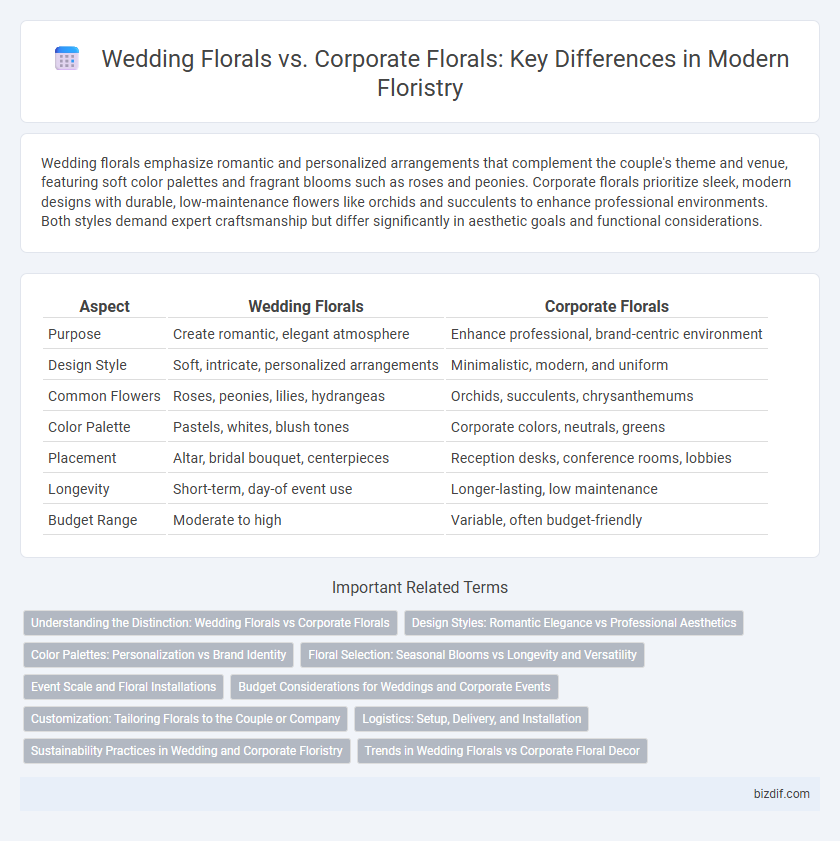Wedding florals emphasize romantic and personalized arrangements that complement the couple's theme and venue, featuring soft color palettes and fragrant blooms such as roses and peonies. Corporate florals prioritize sleek, modern designs with durable, low-maintenance flowers like orchids and succulents to enhance professional environments. Both styles demand expert craftsmanship but differ significantly in aesthetic goals and functional considerations.
Table of Comparison
| Aspect | Wedding Florals | Corporate Florals |
|---|---|---|
| Purpose | Create romantic, elegant atmosphere | Enhance professional, brand-centric environment |
| Design Style | Soft, intricate, personalized arrangements | Minimalistic, modern, and uniform |
| Common Flowers | Roses, peonies, lilies, hydrangeas | Orchids, succulents, chrysanthemums |
| Color Palette | Pastels, whites, blush tones | Corporate colors, neutrals, greens |
| Placement | Altar, bridal bouquet, centerpieces | Reception desks, conference rooms, lobbies |
| Longevity | Short-term, day-of event use | Longer-lasting, low maintenance |
| Budget Range | Moderate to high | Variable, often budget-friendly |
Understanding the Distinction: Wedding Florals vs Corporate Florals
Wedding florals emphasize romantic, personalized designs featuring seasonal blooms and intricate arrangements that complement the couple's theme and venue, creating an intimate atmosphere. Corporate florals prioritize sleek, professional aesthetics with durable, low-maintenance flowers that reflect brand identity and enhance office or event spaces without overwhelming the environment. Recognizing these distinct goals helps florists tailor their approach to meet the specific emotional and functional needs of weddings versus corporate settings.
Design Styles: Romantic Elegance vs Professional Aesthetics
Wedding florals often showcase romantic elegance with soft color palettes, lush blooms like roses and peonies, and flowing arrangements that create an intimate, dreamy ambiance. Corporate florals prioritize professional aesthetics, featuring sleek designs with structured shapes, minimalistic greenery, and neutral or branded color schemes to enhance business environments. The contrast highlights how floristry adapts design styles to suit the emotional tone of weddings versus the formal atmosphere of corporate settings.
Color Palettes: Personalization vs Brand Identity
Wedding florals emphasize personalized color palettes that reflect the couple's unique style, often incorporating soft pastels, romantic reds, and seasonal blooms to create an intimate atmosphere. Corporate florals prioritize brand identity, utilizing company colors and sleek, modern arrangements to reinforce professional image and consistency across events. Understanding the distinct goals behind these floral color choices ensures tailored designs that resonate with their respective audiences.
Floral Selection: Seasonal Blooms vs Longevity and Versatility
Wedding florals prioritize seasonal blooms such as peonies, roses, and lilacs to enhance the event's aesthetic with fresh, vibrant colors that align with specific wedding themes. Corporate florals focus on longevity and versatility, often using hardy flowers like orchids, chrysanthemums, and succulents that maintain appearance over extended periods and suit professional environments. Selecting either seasonal or long-lasting florals depends on the event type, ensuring floral arrangements meet both visual appeal and functional durability requirements.
Event Scale and Floral Installations
Wedding florals often involve intricate, large-scale floral installations tailored for intimate, memorable settings such as altars, aisles, and reception tables, emphasizing personalized design and seasonal blooms. Corporate florals prioritize scalable, sophisticated arrangements suitable for expansive venues like conference halls, lobbies, and trade show booths, often leveraging modern, minimalist designs to align with brand aesthetics. The scale of installations varies significantly, with weddings focusing on emotional impact while corporate events emphasize brand visibility and space enhancement.
Budget Considerations for Weddings and Corporate Events
Wedding florals typically require a higher budget due to the need for personalized arrangements, seasonal blooms, and elaborate designs that complement the bride's theme and venue aesthetics. Corporate florals often prioritize cost-efficiency and durability, utilizing more neutral color palettes and reusable elements to align with brand identity and recurring event schedules. Budget allocation for weddings usually covers premium flower types and intricate setups, whereas corporate events focus on scalability and maintaining a professional ambiance within controlled expenses.
Customization: Tailoring Florals to the Couple or Company
Wedding florals demand intricate customization to reflect the couple's unique love story, incorporating personalized color schemes, seasonal blooms, and symbolic flower choices that enhance the ceremony's theme. Corporate florals prioritize branding and professionalism, using customized arrangements that align with company colors, logo motifs, and event objectives to reinforce corporate identity. Both contexts require expert design skills to balance aesthetic appeal with personalized intent, ensuring each arrangement resonates with its intended audience.
Logistics: Setup, Delivery, and Installation
Wedding florals require precise timing and delicate handling, with setups often scheduled on the event day to ensure freshness and perfect presentation, involving coordination with multiple vendors and venues. Corporate florals demand consistent delivery schedules, frequently involving early morning setups to avoid disrupting business operations, and installations that emphasize long-lasting arrangements with low maintenance. Both types necessitate skilled logistics teams to manage transport, on-site assembly, and quick adjustments to accommodate last-minute changes.
Sustainability Practices in Wedding and Corporate Floristry
Wedding florals emphasize sustainability through locally sourced, seasonal blooms and reusable arrangements, reducing waste and carbon footprint, while corporate florals prioritize long-lasting, low-maintenance plants and eco-friendly delivery methods to lower environmental impact. Both sectors integrate compostable materials and recycled containers to promote circularity in floristry. Sustainable practices in wedding and corporate floristry contribute significantly to greener events and corporate responsibility initiatives.
Trends in Wedding Florals vs Corporate Floral Decor
Wedding florals increasingly emphasize personalized, seasonal blooms and organic textures that evoke romance and intimacy, while corporate floral decor trends favor minimalist arrangements with sleek greenery and structural designs to complement professional environments. Sustainable sourcing and locally grown flowers dominate both sectors, but weddings prioritize vibrant color palettes and intricate details, contrasting with the corporate preference for muted tones and low-maintenance greenery such as succulents and air plants. Innovations in floral foam alternatives and biophilic design principles enhance the natural aesthetic across wedding and corporate settings, reflecting a broader commitment to eco-friendly practices in floristry.
Wedding florals vs Corporate florals Infographic

 bizdif.com
bizdif.com